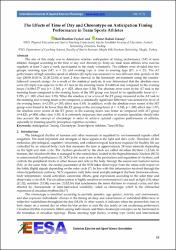| dc.contributor.author | Ceylan, Halil Ibrahim | |
| dc.contributor.author | Günay, Ahmet Rahmi | |
| dc.date.accessioned | 2020-11-20T14:39:25Z | |
| dc.date.available | 2020-11-20T14:39:25Z | |
| dc.date.issued | 2020 | |
| dc.identifier.issn | 2322-3537 | |
| dc.identifier.uri | https://hdl.handle.net/20.500.12809/424 | |
| dc.description | WOS: 000551915700003 | en_US |
| dc.description.abstract | The aim of this study was to determine whether anticipation of timing performance (AT) of team athletes changed according to the time of day and chronotype. Forty-six male team athletes who exercise regularly at least 3 days a week, participated in the study voluntarily. The athletes were divided into two groups: morning type (MT, n = 23) and evening type or close to evening type (ET, n = 23). The AT performance at high stimulus speed of athletes (12 mph) was measured in two different time periods of the day (08.00-10.00 h, 20.00-22.00) at least 2 days interval in the laboratory environment using the counterbalanced research design. As a result of the statistical analysis, it was determined that the absolute error score (12 mph) was superior in the AT task in the morning hours (13.64 +/- 5.44 ms) compared to the evening hours (16.08 +/- 3.77 ms) (t = -2.361, p = .023, effect size: 0.34). The absolute error score in the AT task in the morning hours compared to the evening hours of the MT group was found to be significantly lower (t = -9.293, p = .000, effect size: 1.93). When the absolute error scores of the ET group measured in the AT task in the morning and evening hours were compared, a statistically significant difference was detected in favor of the evening hours. (t=3.133, p=.005, effect size: 0.65). In addition, while the absolute error scores of the MT group were found to be lower than the ET group in the morning hours (t = -5.345, p = .000, effect size: 1.57), the absolute error scores of the ET group in the evening hours was better as compared with MT group (t=4.420, p=.000, effect size: 1.30). It is extremely important that coaches or exercise specialists should take into account the concept of chronotype in order to achieve optimal cognitive performance of athletes, especially in planning specific perceptual-cognitive exercises. | en_US |
| dc.item-language.iso | eng | en_US |
| dc.publisher | Int Journal Applied Exercise Physiology | en_US |
| dc.item-rights | info:eu-repo/semantics/openAccess | en_US |
| dc.subject | Anticipation Timing | en_US |
| dc.subject | Chronotype | en_US |
| dc.subject | Team-Sports Athletes | en_US |
| dc.subject | Time of Day | en_US |
| dc.title | The Effects of Time of Day and Chronotype on Anticipation Timing Performance in Team Sports Athletes | en_US |
| dc.item-type | article | en_US |
| dc.contributor.department | MÜ, Spor Bilimleri Fakültesi, Antrenörlük Eğitimi Bölümü | en_US |
| dc.contributor.institutionauthor | Günay, Ahmet Rahmi | |
| dc.identifier.volume | 9 | en_US |
| dc.identifier.issue | 7 | en_US |
| dc.identifier.startpage | 19 | en_US |
| dc.identifier.endpage | 29 | en_US |
| dc.relation.journal | International Journal of Applied Exercise Physiology | en_US |
| dc.relation.publicationcategory | Makale - Uluslararası Hakemli Dergi - Kurum Öğretim Elemanı | en_US |


















